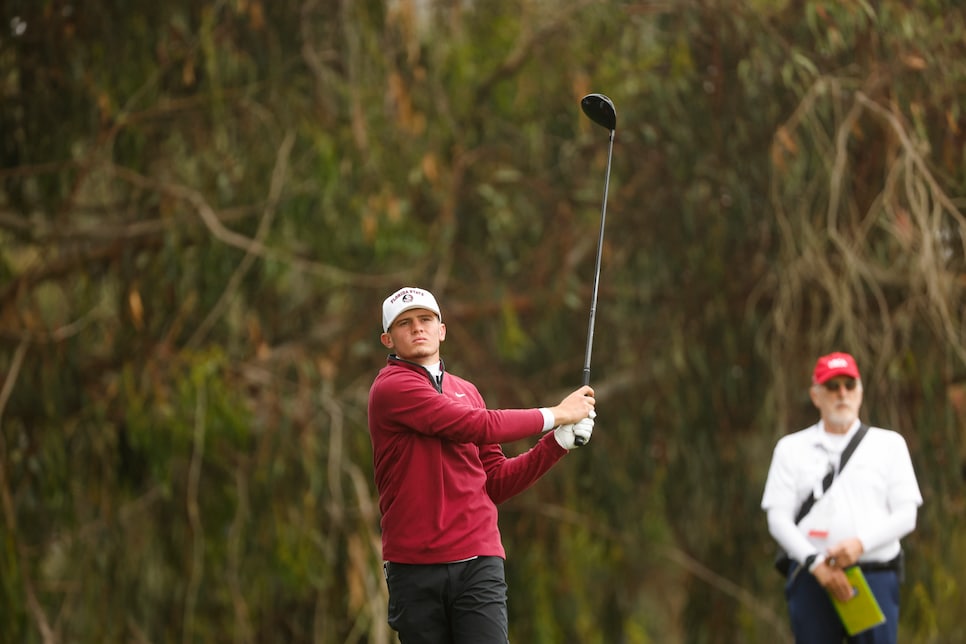SAN FRANCISCO — If Final Qualifying for the U.S. Open is annually dubbed “Golf’s Longest Day,” the U.S. Amateur (or any of the USGA’s amateur championships) can certainly be called Golf’s Longest Week. The players who advance all the way to Sunday’s championship match will have played nine competitive rounds in seven days at The Olympic Club. Factor in the steep grade of the Lake Course’s slopes, aided only by the Bay Area’s cool air, and this week is as physical a test as any in golf.
Critical to having success on the course will be how players manage the few hours when they are not playing. Luckily, today’s top amateurs are better equipped than ever to master their post-round recovery and pre-round warmups thanks to increased attention and investment made to both at the collegiate level. Strength and conditioning coaches along with physical therapists and nutritionists are playing a more central role than ever in the top players’ development.
Take Alex Merrill and his career trajectory as an example. A certified strength and conditioning coach who has long specialized in golf performance, Merrill spent 12 years as a performance coach at Duke, where he trained the men’s and women’s golf teams, as well as the wrestling and women’s tennis squads. After a couple years in a similar, though more golf-centered role at Purdue, Merrill was hired in 2024 by the Stanford men’s golf team not as a trainer but as an Assistant Coach. The distinction is important because it underscores how college programs are valuing holistic performance coaches as integral members of the travel squad, not ancillary figures that the team sees a few times a week.
MORE: U.S. Amateur contender was in ‘swing prison.’ This pre-shot mental strategy unlocked his game
As one of Stanford’s assistants, Merrill travels to tournaments and helps prepare team members for competition by overseeing all aspects of recovery and pre-round preparation, in addition to designing strength and conditioning programs. “My role has gotten pretty comprehensive,” Merrill says. “We’re able to dial in everything. We’re looking at their nutrition at a much higher level. I’m able to run them through recovery modalities. We’re providing more of a PGA Tour-type experience at Stanford, and I think a lot of other schools are starting to catch on to that and create the same kind of model that we have.”

His role overseeing the health of the Stanford men’s golf team is so important that Alex Merrill (left) holds the position of assistant coach rather than merely a trainer.
Courtesy of Stanford
At the U.S. Amateur, players are applying the practices that Merrill and other top performance coaches prescribe during the season to help them stay fresh throughout the grueling week. “Recovery after a round is one of the most important things to prepare yourself for your upcoming play,” Merrill says. “ If you’re not taking care of yourself, then the next day you’re going to get up and something’s not going to feel right, and your body’s not going to be able to execute the same way it did the day before.”
Recovery, roughly speaking, can be broken down into three categories that all interact and affect each other: Nutrition and hydration, body maintenance and sleep.
Nutrition and hydration
“First of all, I make sure I get good food. Protein and carbs, not much fat at all,” says Virginia’s Paul Chang about his post-round routine.
Tyler Weaver, a rising junior at Florida State who is 11th in the World Amateur Golf Ranking echoed those thoughts. “I definitely look at what I’m eating, trying to get enough protein and carbs for the next day,” says the Englishman.

Paul Chang plays his tee shot on the second hole during the round of 32 of the 2025 U.S. Amateur at The Olympic Club.
Chris Keane
Merrill says that protein and carbs is part of the “balance plate” strategy that he prescribes as well. At each meal, players eat a lean protein, a complex carbohydrate and a vegetable. During competition and strenuous activity, the protein and carbs become even more important to replenish the depleted energy and prepare for the following day’s demands. “When players come off the course, they need to get some high-dense carbohydrates into their body,” Merrill says.
Hydration is a focus, as well, which can be particularly challenging in cooler climates like San Francisco, when players may not feel as thirsty. Still, the traditional rule of drinking half your body weight in ounces each day holds. Players drink even more during tournaments, and a bottle of water every few holes is not uncommon.
Body maintenance
Players use many strategies to rejuvenate their muscles. “I’ll stretch before I go to bed. I try to take a long, hot shower to get the muscles relaxed, especially ones that typically get tense,” Chang says. “Before my round, I’ll stretch a little, too, and use a foam roller. That’s really helpful.”
MORE: Why the next generation of top amateurs is finally killing this putting myth
Taking advantage of equipment and amenities at Olympic Club is also something many players are doing. “I came to the course a little early, got in the hot tub to loosen myself up,” says Jackson Herrington, a 2024 U.S. Amateur Four-Ball runner-up who is having success this week with a unique pre-shot mental strategy. “I use the Normatec boots they have in [the clubhouse]. Then use a massage gun. I do all of the stretches that our trainer at the university gives us.”
Indeed, Normatec boots and other similar leg compression devices are some of the most high-tech options. The boots cost more than $1,000, but Herrington estimates Tennessee has about six of them. Stanford has plenty as well, and Merrill encourages alternating hot and cold showers to get similar benefits. Foam rolling helps ease soreness, and golf-specific stretching routines help alleviate tension in areas of the body, like the hip flexors and thoracic spine, that tend to tighten up in golfers.

Tyler Weaver plays his tee shot on the second hole during the round of 32 of the 2025 U.S. Amateur at The Olympic Club.
Chris Keane
“For me, always having enough energy to go out and play the next day is more important than doing a bit of practice afterwards,” Weaver says. “It’s about maintaining how you feel and getting ready for the next day.”
Sleep
Merrill says the most important factor to maximizing recovery, however, is sleep. “You can eat well and you can be hydrated, but if you sleep really terribly, your body is going to feel awful,” Merrill says. “ Your mind is not going to process correctly. You’re not going to be able to execute and make high level decisions on the golf course.”
How much are players focused on sleep?
“A lot. Usually, I try to get at least eight hours,” Chang says.
“It’s big,” Herrington says. “Sometimes I don’t play too good on no sleep, so I try to listen to my Whoop and usually try to get around eight hours. Here it’s pretty easy to do because I’m tired at 9 p.m.”
“It’s a huge part of the process and getting enough sleep is massively important,” Weaver says.
With early and late tee times at the U.S. Amateur (or any competitive event), maximizing quality sleep requires intention and discipline to get to bed earlier than usual when players have early tee times. Merrill says keeping a cool, totally blacked out room helps facilitate restorative sleep, which many players track using Whoop fitness bands or others form other brands.
Still, with alarms set as early as 4:30 a.m. for tee times, it’s not always possible to get an ideal eight hours. That’s why Chang’s head coach at Virigina, Bowen Sargent, teaches his players to embrace the inevitable sleep deprivation. “We all get used to it because we travel so much,” Chang says. “It’s just part of our lives to not sleep well. Our coach says you need to learn how to perform sleep deprived, and then you’ll be ready for college golf.”
Nutrition and hydration, body maintenance and sleep—three essential components to recovery that today’s best young players are focused on now, more than ever.
“These kids today are doing a lot better at recovering,” Merrill says. “I’m seeing less kids eat Snickers on the course and more kids carrying around beef jerky and having premade sandwiches that they prepare the night before to make sure that they’re prepped for that round.”
This article was originally published on golfdigest.com




